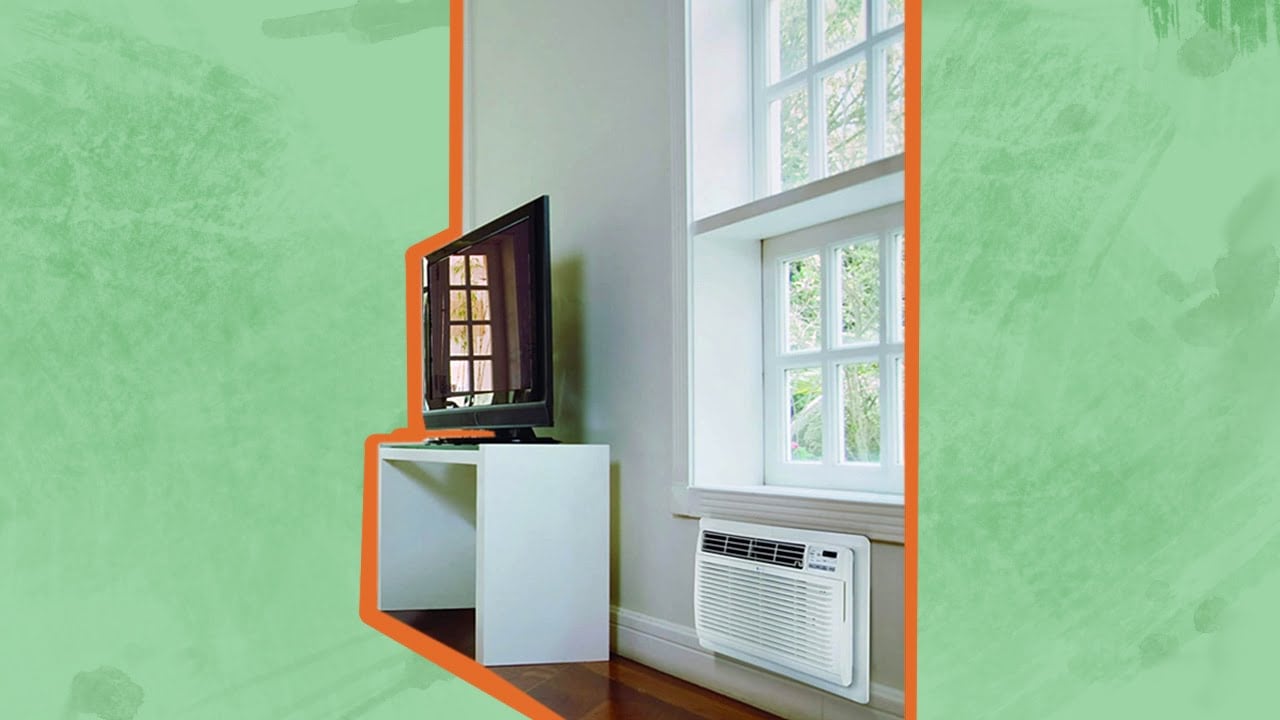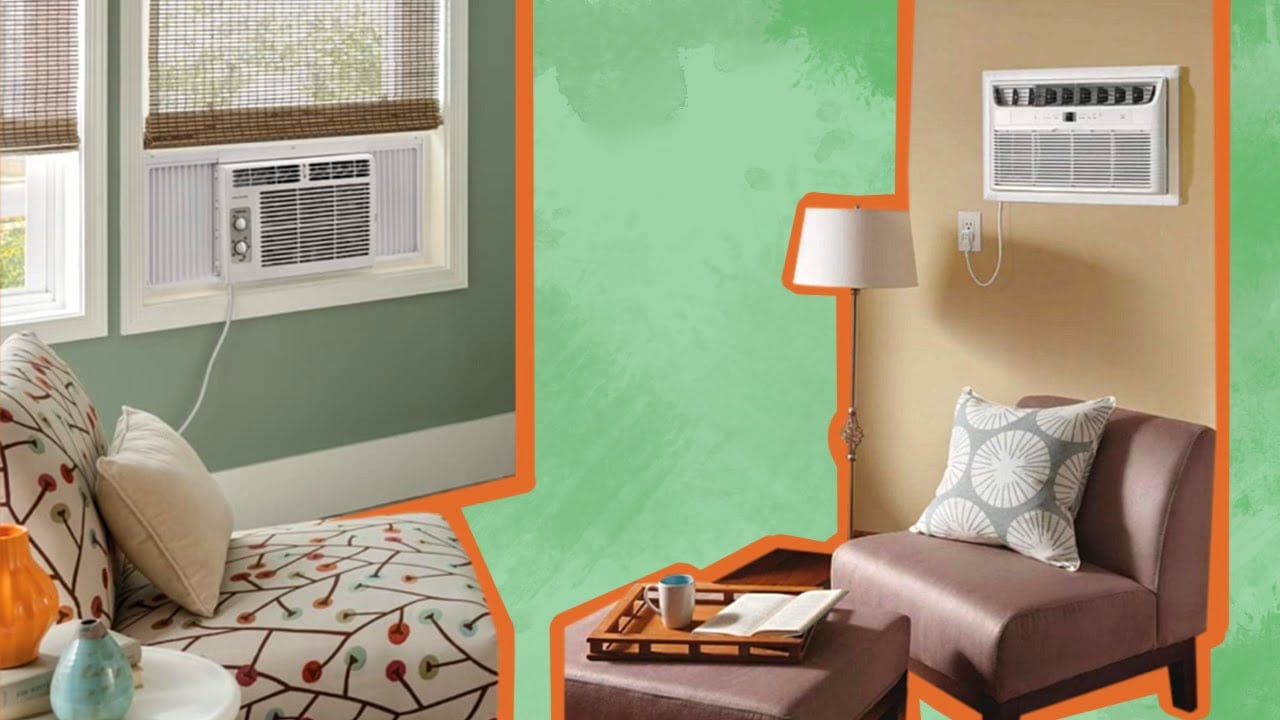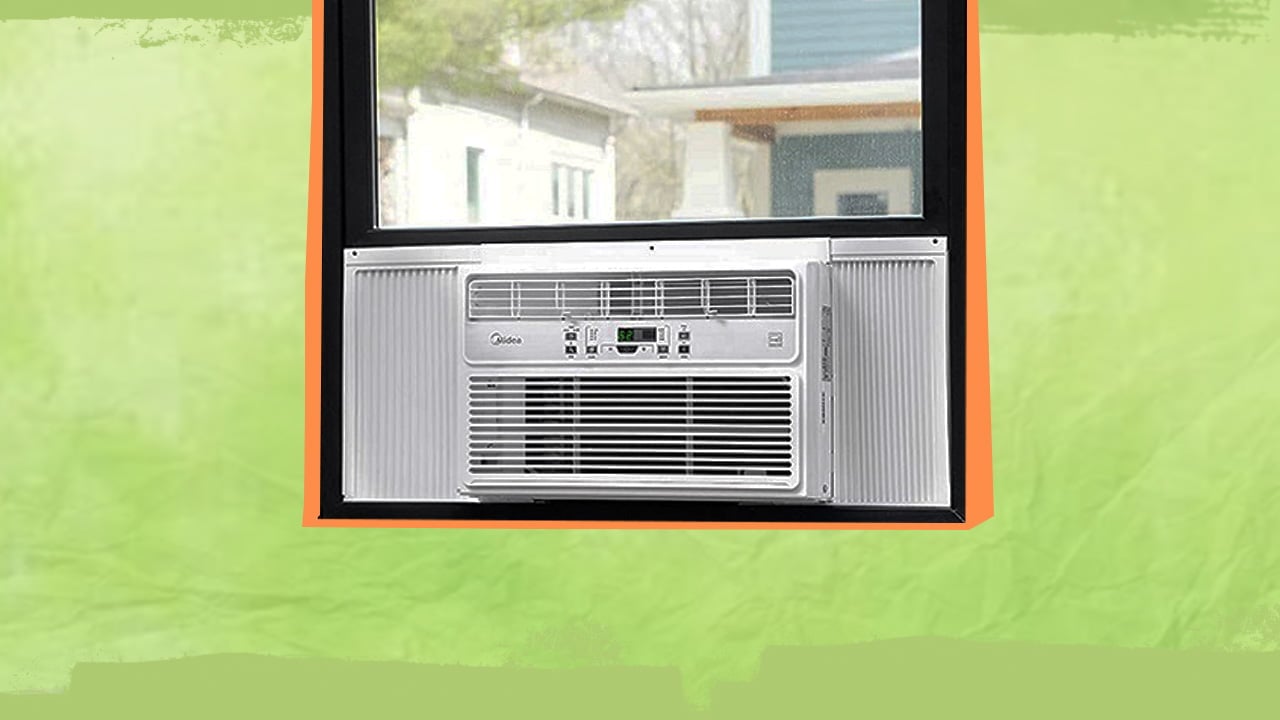Despite the structural and operational similarities between window ACs and wall ACs, differences like the installation method, running cost and cooling efficiency separate the two. Window ACs are more affordable and have versatile cooling capabilities, while wall ACs are quieter and more energy-efficient.

Window and wall air conditioners are two of the most widely used AC types on the market for personal use.
Both AC types serve well as the primary cooling device, but there are several differences that make them better for one use-case over another. This makes choosing between them quite the complex affair, as each air conditioner has its benefits and drawbacks.
So, let’s explore both AC types in great detail to see which one fits your needs the best!
How An Air Conditioner Works

To understand what makes window and wall air conditioners more preferable, it would be better to know how an AC works first. At its core, the purpose of an air conditioner is to reduce the ambient temperature and humidity in a room.
The way it achieves this is by using a liquid refrigerant as a coolant, which is run through coils known as evaporator coils. AC units typically have a fan set up behind the evaporator coils that blow the cold air produced by the refrigerant into the room. At the same time, the liquid refrigerant absorbs the heat from the room.
This turns the refrigerant into a gas, which is then redirected towards the compressor. Next, the compressor compresses the refrigerant into a high-pressure gas, after which it flows through the condenser coils. Here, another fan blows over the refrigerant to reduce its heat which turns it back into a liquid, ready to be reused.
Window Air Conditioners
Window air conditioners are one of the simplest air conditioning solutions, usually mounted on a window. This AC type comes with all the complex working parts of the air conditioner housed in a single unit, which simplifies the installation process.
How A Window Air Conditioner Works
There aren’t many things that separate a window air conditioner from others in terms of its way of operation. The largest differentiator here is that the air conditioner is a single unit, which makes understanding its working process simpler.
The Inner Components Of A Window Air Conditioner
A typical window air conditioner comes with a double-shaft fan motor that has fans affixed to both sides of the motor. These fans are positioned at the evaporator and condenser sides, which enables the cooling effect of the fan.
Located at the front of the air conditioning unit is the evaporator side that expels conditioned air into the room. This is where the cooling coil, evaporator blower, operation panel with digital controls, filter drier, and drain pan are located. Most of the heavy lifting when it comes to cooling happens here.
At the back of the AC unit is the condenser side that lets out hot air. The back of the air conditioner includes components critical to air conditioning, such as the compressor, propeller fan, condenser coil, and fan motor.
If you’ve ever peeked at the inner workings of a window AC, you may have found an insulated partition that separates the two sides. This parting keeps the warm and cool sides of the air conditioner completely isolated from one another. In turn, both sides of the window air conditioner work in tandem to keep your home cool.
The Advantages
1. Affordable Cost
Window air conditioners tend to have a low purchasing price and cost less to operate. This is in sharp contrast against other AC types like a wall-mounted air conditioner. They are known to be expensive to buy and run on a monthly basis.
The reason for this is two-fold: the low installation costs and relatively simple construction. Owing to a simple installation process, the charges for having a window unit installed are quite low.
And since all the working parts of the unit are assembled in a single box, the overall cost of the unit reduces drastically.
2. High Energy Efficiency
Few air conditioner types can match the energy efficiency of a window AC. The Energy Efficiency Ratio (EER) of most window air conditioner units is usually quite high, meaning that they consume less power to run effectively.
Some ACs also come with an Energy Star rating that denotes how energy efficient the device is. You will be saving a lot of money on electricity bills by using a window AC over other air conditioner types.
3. Versatile Cooling Capabilities
Window units generally offer a high cooling capacity, ranging from 5,000 to 12,500 British Thermal Units (BTU). And combined with their low running cost, they give you the biggest bang for your buck. These are often more powerful than other air conditioner types.
Additionally, they can serve as a low-cost addition to your existing HVAC (Heating, Ventilation, and Air Conditioning) system as a supplemental cooling unit. You can use central air conditioning to regulate the temperature of the entire house with a window AC to keep a specific room cool.
The principle behind using a window air conditioner for supplemental cooling is to reduce the load on the HVAC system. What this does is it causes the HVAC system to consume less power, dramatically reducing your overall energy costs.
And combined with the already low energy requirements of a window AC, you may see a sharp decline in your overall electricity costs.
4. Saves Floor Space
Window Air Conditioners don’t take up any floor space inside or outside your house. The indoor unit remains out of the way and doesn’t need to be moved to create space. And there is no outdoor unit that takes up valuable space on your roof.
If you’re looking for an air conditioner to install in a smaller space, a window AC will serve just fine. You won’t need to reorganize an already cramped space to make room for the cooling device.
The Disadvantages
1. Noise Levels
Window AC units tend to be quite loud due to the way they are constructed. Other air conditioner types have some sort of extended separation between the evaporator and condenser sides, whereas window units don’t.
If you’re a light sleeper, the noise produced by window units can be quite troublesome.
2. Reduced Natural Light
A window AC is not exactly small, which means that it will occupy a significant portion of your window. Not only will this obstruct your outdoor view, but it will also prevent natural light from entering the room.
If you’re fond of the morning sunshine pouring through the windows, a window AC may not be the best option.
Wall Air Conditioners
At first glance, wall air conditioners appear similar to window air conditioners, except that they are installed directly into an exterior wall. The area around the inner unit is sealed with a robust trim, preventing cool or fresh air in the room from escaping.
Due to their constructions being so similar, both wall and window units share many advantages and disadvantages.
The Inner Workings Of Wall Air Conditioners
Much like window air conditioners, through-the-wall units are a single unit that includes both the condenser and evaporator sides. And since they have similar basic construction, wall air conditioners work the same way as window AC units.
Both have inner units that contain the cooling coil, operation panel, filter drier, evaporator blower, and drain pan. And they have outer units with a compressor, propeller fan, condenser coil, and fan motor.
Installation location aside, the largest difference between window and wall ACs is that through-the-wall AC units vent only through the back of the ACs. Window units, on the other hand, can vent from the back and sides of the outer unit.
The Advantages
1. Unobstructed Window
Since these are installed directly onto an external wall, your window remains free of a large unit blocking it. Wall air conditioners sit in a pre-set sleeve made into the exterior wall specifically for this purpose, which keeps it secure and out of your way.
The view from your window will remain as gorgeous as ever with a wall air conditioner installed.
2. Quiet Operation
During installation, the wall sleeve is sealed thoroughly to prevent air from leaking and keep the air conditioner efficient. As a consequence, the exterior unit is left on the other side of the wall, which dampens its noise quite a bit.
Light sleepers may not be disturbed by the running noises of the wall air conditioner.
3. No Ductwork Required
Ductwork can become quite expensive when installing an AC, particularly when ducts have to run through every room. Not only can it burn a hole through your pocket, but it is also extremely inconvenient for your family.
The pre-installed sleeve aside, wall ACs require no major changes to the construction of your house. So, skipping out on ductwork can be a major boon to your wallet and the tranquility of your home.
4. Better Temperature Control
You have a greater degree of control over the ambient temperature with a wall air conditioner through a cool or heat mode. A wall air conditioner is capable of heating or cooling a single room effectively, making it cooler or warmer than the rest of the house.
The Disadvantages
1. Relatively High Installation Cost
A wall AC can’t simply be set up on a window frame. If you don’t have a wall sleeve installed in an exterior wall already, having a wall air conditioner fitted can become quite expensive. The installation will involve making room on an external wall for the sleeve and then proceeding with the regular installation process. This is both time-consuming and expensive, which can quickly lighten your wallet.
Additionally, some wall AC models don’t include a wall sleeve, requiring you to purchase one separately. This can further add to the professional installation costs.
2. They Are A Permanent Fixture
It takes a great deal of effort to replace a wall air conditioner with another. And if you’re thinking about replacing it with a different AC type, you may also have to think about the giant hole in the wall.
Even replacing wall conditioners with one of the same type is a hassle. Unless you purchase the same model, the new AC will likely not fit in the wall sleeve and will require additional modifications.
Tip
Through-the-wall air conditioners are a long-term commitment. So, if you’re looking to buy a wall AC, it’s best to think twice.

Comparing Both AC Types
Despite both air conditioners being quite similar in construction and operation, they have major differences with their own unique advantages and disadvantages. Because of these specific pros and cons, picking one over the other is not an easy task.
Let’s compare a few aspects of window ACs against wall ACs to see which one comes out on top.
1. Cooling Capacity
Window air conditioners have a higher cooling power, cooling down rooms as large as 1,500 square feet. Through-the-wall ACs, on the other hand, are capable of effectively cooling areas up to 700 square feet in size.
2. Efficient Energy Use
The use of an air-tight seal around wall air conditioners makes all the difference when it comes to energy efficiency. Thus, through-the-wall ACs consume less energy than window air conditioners, provided that both units are equivalent counterparts of one another.
3. Ease Of Installation
Installing window ACs is a job that requires no more than one technician to set it up in a specified window space. The same can’t be said about wall ACs, giving window air conditioners a clear win in this category.
4. Noise Levels
Window air conditioners are noisy, but wall ACs have a way of mitigating the noise. Thus, through-the-wall air conditioners would be preferable for quieter operation.
5. Cost
Overall, wall units are more expensive to set up and operate. Additionally, since they require permanent installation, they need to be able to withstand the weather which necessitates periodic maintenance.
Window ACs, being more portable and highly affordable to buy and run, are better in this category.
Air Conditioner Maintenance
AC maintenance is a key part of the longevity of any cooling unit. As such, the ease of maintenance becomes a significant point of discussion when purchasing an air conditioner.
What follows is a brief overview of the maintenance process of each air conditioner type.
1. How To Maintain Window ACs
Maintaining a window AC unit is not a highly involved process. As a general rule, you would want to have the unit serviced at least once a year in addition to regular cleaning. The former is best left to a professional, while you can do the latter on your own.
Cleaning a window unit involves the following steps:
- Cleaning the washable air filters
- Clearing the coil fins
- Realign any bent fins
- Clean the fans and the drain pan
Tip
Be sure to use a rag with a bit of warm, soapy water for cleaning your window air conditioner. And once summer is long gone, consider unmounting and storing the air conditioner until it arrives again. You may keep the AC in a safe spot like a backyard shed or garage during the winter. This will help keep it in good shape for years to come.
2. How To Maintain Wall ACs
The cleaning process of wall AC units is similar to that of window ACs, with the only difference being the cleaning frequency. Since wall ACs are a permanent fixture, you will need to maintain them more often. And due to their immovable nature, they can be a bit finicky to clean.
Should you ever run into an issue with your through-the-wall air conditioner, do not hesitate to contact a professional for help.
Leaving either a window or wall air conditioner running all day is not an ideal proposition. By doing so, the air conditioning unit will run for a long time, consuming more energy and increasing the electricity bills. Moreover, you risk overloading the AC and eventually causing it to malfunction. A window AC will serve you consistently well for eight to ten years on average. Depending on the build quality and maintenance frequency, it may last even longer. On the other hand, a wall unit will last up to 10 years with proper care. This is easier said than done, though, since wall air conditioners require more maintenance than window ACs.Window And Wall AC Related FAQs

Conclusion
There is quite a large overlap in the functionalities and purpose of window and wall air conditioners. They share a near-identical structure and several benefits, but a few key points make all the difference when picking one over the other.
If you’re looking for a cooling device that is easy to run and has low overall costs, a window unit will serve you well. It will continue to run for nearly a decade, so long as you maintain the unit properly.
But if you want long-term savings and don’t mind a permanent cooling device in your room, a wall AC could be the way to go. It will be highly energy-efficient throughout its lifespan and run quietly until it runs its course.
At the end of the day, the right air conditioner pick here depends on your cooling needs.
